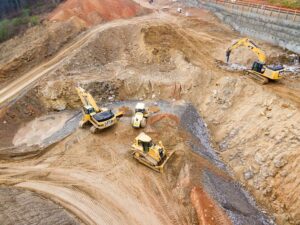Kentucky Sitework Regulations: Comprehensive Guide to Commercial Excavation, Foundation, and Civil Works Compliance
Kentucky’s sitework regulations establish a clear framework for land disturbance, excavation safety, foundation preparation, and stormwater control to protect public safety and environmental quality. This guide delivers actionable explanations of key permit requirements, safety standards, code mandates, and compliance strategies that commercial contractors and project managers must follow. Readers will explore:
- Essential land disturbance and stormwater permits
- Excavation safety protocols and Kentucky 811 notification
- Foundation depth criteria and soil testing under the Kentucky Building Code
- Local versus state permit variations and environmental impact assessments
- Stormwater pollution prevention planning and BMP implementation
- How Earth Works, LLC supports seamless regulatory navigation
By defining each regulation, explaining its purpose, and illustrating real-world examples, this guide builds a coherent compliance roadmap.
Whether you handle grading, trenching, or foundation work, you’ll gain clarity on obligations and avoid project delays or penalties.
What Are the Key Kentucky Land Disturbance Permits for Sitework?
Kentucky Land Disturbance Permits regulate activities that alter the ground surface to control erosion, sediment discharge, and water quality impacts. These permits protect waterways by mandating erosion and sediment control plans for projects exceeding disturbance thresholds—for example, clearing more than one acre on a commercial site triggers a permit requirement. Clear permit identification prevents enforcement actions and supports project scheduling.
Land Disturbance Permits fall into two primary categories:
- Land Disturbance Permit (Statewide)—covers any project disturbing one acre or more under the Kentucky Energy and Environment Cabinet.
- Local Site Disturbance Permit—required in jurisdictions like Louisville MSD for projects disturbing over 2,000 square feet.
What is a Kentucky Land Disturbance Permit and When Is It Required?
A Kentucky Land Disturbance Permit is a state-issued authorization for earth-disturbing activities that exceed one acre or require local agency review. It ensures an approved erosion and sediment control plan is in place before site clearing begins, reducing runoff pollution. For instance, a retail development in Lexington would need this permit once grading exceeds the one-acre threshold.
How to Apply for a Land Disturbance Permit in Kentucky: Step-by-Step Process
To secure a Land Disturbance Permit, follow these procedural steps:
- Prepare an Erosion Prevention and Sediment Control (EPSC) plan including site maps, control measures, and schedules.
- Complete the Notice of Intent form for the Kentucky Division of Water.
- Submit the EPSC plan, NOI, and permit fee to the Energy and Environment Cabinet.
- Address any agency comments and revise plans as required.
- Receive permit issuance and begin permitted land-disturbing activities.
These steps streamline approval and integrate erosion control before sitework commences.
What Are the Erosion and Sediment Control Plan (EPSC) Requirements in Kentucky?
An EPSC plan specifies measures to limit soil erosion and trap sediment during construction, ensuring water quality protection. Key elements include soil stabilization, sediment barriers, inlet protection, and inspection schedules.
These components work in concert to maintain compliance with permit conditions and minimize environmental impact.
How Does the KPDES General Permit Affect Sitework Projects?
The Kentucky Pollutant Discharge Elimination System (KPDES) General Permit governs stormwater runoff from construction sites disturbing one acre or more. It mandates a Stormwater Pollution Prevention Plan (SWPPP) aligned with EPSC measures and requires submission of a Notice of Intent. Compliance with KPDES ensures permitted discharge limits and reporting schedules are met, protecting downstream water bodies from sediment-laden runoff.
What Are the Consequences of Non-Compliance with Land Disturbance Regulations?
Failure to secure or adhere to land disturbance permits can result in stop-work orders, fines up to thousands of dollars per day, and mandated corrective actions. Regulatory agencies may require re-stabilization, additional monitoring, or costly retrofit measures. Maintaining permit compliance safeguards project timelines and budgets.
Kentucky Sitework Regulations: Permits, Safety & Stormwater Compliance
Kentucky excavation safety standards set by OSHA and state law prevent cave-ins, utility strikes, and worker injuries during sitework. These regulations require pre-excavation planning, protective systems, and competent person oversight, ensuring a secure work environment. Adhering to safety measures reduces liability and enhances project continuity.
When and How to Contact Kentucky 811 Before Excavation?
Kentucky law mandates notifying Kentucky 811 at least two full working days before any excavation that could affect underground utilities. This one-call system locates and marks buried cables, pipelines, and wires to prevent utility strikes. For example, scheduling an 811 request before trenching for a new water line ensures marked utility paths and safe digging zones.
What Are Kentucky OSHA Excavation Safety Standards and Best Practices?
OSHA excavation safety standards require protective systems—sloping, benching, shoring, or shielding—for trenches deeper than 4 feet. Soil classification determines protective design, while daily inspections by a competent person identify hazards. Best practices include emergency access points, spoil pile positioning, and clear communication protocols to enhance excavation safety.
How Do Trenching and Shoring Regulations Ensure Excavation Safety in Kentucky?
Trenching regulations outline specific protective measures based on trench depth and soil type. Shoring systems use hydraulic jacks and panels to shore walls, while sloping angles prevent collapse by tapering trench walls. These measures stabilize excavation sidewalls, safeguarding workers and equipment and preventing ground falls.
Who is a Competent Person and What Is Their Role on Excavation Sites?
A competent person is an individual with training and experience to recognize excavation hazards, test soil conditions, and implement corrective actions. This role involves daily site inspections, verifying protective systems, authorizing entry, and halting unsafe work. Assigning a competent person ensures regulatory adherence and continuous hazard management.
What Are the Kentucky Building Code Requirements for Foundation Preparation?
The Kentucky Building Code (KBC) based on the 2015 International Building Code sets minimum foundation depths, soil bearing capacities, and testing protocols to guarantee structural stability. Foundation preparation regulations apply to commercial projects and prevent settlement or structural failure by enforcing standardized design criteria and verification methods.
Proper foundation practices under the KBC protect investments and building occupants by aligning construction with engineering standards.
What Are the Minimum Foundation Depths and Soil Testing Standards in Kentucky?
Adhering to these criteria ensures code compliance and long-term foundation performance.
How Does the Kentucky Building Code Influence Commercial Site Grading?
Commercial site grading under the KBC requires proper drainage slopes, compaction standards, and erosion controls to protect foundations and adjacent properties. Grading plans must demonstrate two-percent minimum slopes away from structures, allow safe runoff, and integrate EPSC measures until landscaping or paving is complete.
What Are Best Practices for Code-Compliant Foundation Preparation?
Best practices include early geotechnical surveys, precise excavation to design elevations, proven compaction methods, and regular inspection reports. Coordinating foundation work with erosion control and grading ensures seamless integration with permit-mandated environmental protection measures and avoids rework.
How to Navigate Commercial Construction Permits and Local Sitework Regulations in Kentucky?
Commercial site development in Kentucky involves overlapping state permits and varying local ordinances. A unified approach includes identifying required state authorizations—such as the Land Disturbance Permit and KPDES General Permit—while mapping municipality-specific requirements for grading, building, and utility connections.
Understanding jurisdictional nuances prevents permit delays and supports consistent project delivery across counties or cities.
What Permits Are Needed for Commercial Site Development in Kentucky?
Commercial developments typically require:
- A Land Disturbance Permit for earth-disturbing activities over one acre
- KPDES General Permit for stormwater discharge
- Building permits under the KBC for foundations and structures
- Local grading or floodplain development permits as dictated by county ordinances
Combining these authorizations in a master permit schedule streamlines approval timelines.
How Do Local Municipality Regulations Differ Across Kentucky?
Local governments may enforce additional stormwater ordinances, floodplain permits, or tree-protection requirements beyond state mandates. For example, Louisville MSD demands site disturbance permits at 2,000 square feet, while Danville’s manual outlines unique BMP criteria. Recognizing these variations ensures full compliance within each jurisdiction.
What Are the Steps for Environmental Impact Assessments in Kentucky Civil Works?
An Environmental Impact Assessment begins with a site evaluation to identify sensitive areas, followed by a scoping report addressing potential effects on water, air, and wildlife. The process involves public notices, agency consultations, and mitigation planning. Final assessments outline permit conditions and long-term monitoring commitments.
What Are the Essential Stormwater Management Regulations for Kentucky Sitework?
Stormwater management regulations in Kentucky aim to reduce pollutant loads from construction runoff through BMP implementation and SWPPP documentation. These rules protect water bodies by controlling the quantity and quality of discharged stormwater, aligning both state and local standards.
Robust stormwater measures enhance project sustainability and mitigate regulatory risk.
How to Develop a Stormwater Pollution Prevention Plan (SWPPP) for Kentucky Projects?
A SWPPP integrates EPSC components with operational controls, outlining site maps, inspection logs, and corrective action procedures. Key steps include:
- Mapping disturbed areas and runoff flow paths
- Selecting structural BMPs such as sediment basins or vegetative swales
- Establishing inspection schedules and spill-response protocols
This plan forms the basis for KPDES compliance and site monitoring.
What Are Kentucky’s Best Management Practices (BMPs) for Stormwater Control?
Implementing these BMPs aligns with permit standards and supports environmental stewardship.
How Does Stormwater Management Prevent Environmental Violations?
Effective stormwater controls minimize sediment transport, nutrient loading, and pollutant discharges, preventing violations under the Clean Water Act and KPDES permit conditions. By maintaining BMP performance through routine inspections and maintenance, projects avoid citations and costly remediation.
How Can Earth Works, LLC Help Ensure Compliance with Kentucky Sitework Regulations?
Earth Works, LLC specializes in guiding commercial sitework through complex regulatory frameworks, offering permit application support, plan preparation, and on-site compliance oversight. Their expertise in Kentucky-specific requirements prevents project delays, reduces risk, and ensures consistent adherence to state and local mandates.
Leveraging proven methodologies and local relationships, this firm delivers turnkey solutions for excavation, grading, and stormwater management.
How Does Earth Works, LLC Assist with Permit Applications and Regulatory Navigation?
Earth Works, LLC prepares complete permit submittals—including EPSC plans, SWPPPs, and building permit packages—and liaises with agencies on behalf of clients. Their step-by-step project coordination ensures timely reviews and approval, integrating digital permitting platforms where available.
What Are Examples of Successful Regulatory Compliance Projects by Earth Works, LLC?
Recent projects include a 2024 Lexington commercial redevelopment where tailored BMP strategies achieved zero permit infractions and a 2025 Louisville multi-use excavation permitting effort that reduced approval time by 30 percent. These case studies demonstrate the company’s efficiency and deep regulatory insight.
How to Request a Consultation for Sitework Regulatory Compliance Assistance?
Engage with Earth Works, LLC by calling or submitting a brief project outline to schedule a tailored consultation. Their team evaluates site conditions, outlines compliance pathways, and prepares permit documentation to position clients for seamless project kick-off.
What Are Common Questions About Kentucky Sitework Regulations?
Construction professionals often seek clarity on permit thresholds, notification timelines, code interpretations, and stormwater obligations. Addressing these recurring themes helps contractors anticipate requirements and integrate compliance steps into project planning without last-minute scrambling.
Key inquiry areas include permit applicability, excavation safety protocols, foundation depth criteria, and stormwater plan development.
What Are the Most Frequently Asked Questions About Land Disturbance Permits?
Contractors typically ask which disturbance thresholds trigger state versus local permits, what documentation each application needs, and how long review cycles take. Common concerns also cover permit renewal conditions and required insurance or bonding.
When Is a Kentucky 811 Call Required Before Excavation?
Excavators routinely inquire about the mandatory two-working-day notice period before digging, how to document utility marks, and the scope of utility locate services provided at no cost.
What Are the Key Foundation Preparation Guidelines Under the Kentucky Building Code?
Frequent questions revolve around frost-depth requirements, soil bearing capacity reports, compaction standards, and inspection protocols for continuous versus isolated footings.
How Do Stormwater Regulations Impact Commercial Sitework Projects?
Project managers often seek examples of approved BMP combinations, inspection frequencies mandated by KPDES, and strategies for maintaining plan compliance during extended construction phases.
Each of these topics highlights areas where early planning and professional guidance—such as that offered by Earth Works, LLC—streamline compliance and keep projects on schedule.
Kentucky’s evolving regulatory landscape demands proactive management of land disturbance, safety, foundation, and stormwater requirements. Armed with clear definitions, procedural steps, and best practices, contractors can secure necessary permits, implement effective controls, and avoid costly enforcement actions. Working with a knowledgeable partner that understands local nuances ensures that every phase of sitework proceeds in full compliance and delivers reliable, sustainable outcomes.


